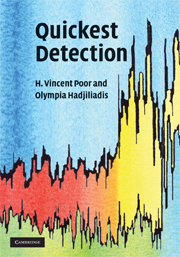7 - Additional topics
Published online by Cambridge University Press: 06 July 2010
Summary
Introduction
In Chapter 4, we considered the problem of optimally deciding between two hypotheses on the state of the environment given a constant cost of sampling for each additional observation. Within each of these two models the data are homogeneous; that is, the data obey only one of the two alternative statistical models during the entire period of observation. In Chapters 5 and 6 on the other hand, we considered the problem of optimally detecting an abrupt change in the mechanism generating the data from one regime to another. In this chapter, we examine several generalizations and modifications of these basic sequential decision–making problems, in which various of the assumptions are relaxed so as to provide more practical solutions.
We will first address the problem of decentralized sequential detection. In this setting information becomes available sequentially at distinct sensors, rather than at a common location, as in the models considered in the preceding chapters. In general, these sensors communicate a summary message to a central fusion center (which may or may not also be receiving information on its own), which must ultimately decide about the state of the environment. Various sensor configurations are possible for decentralized detection. See for example. One of the main advantages of the decentralized setting over its centralized counterpart is the reduced communication requirements of such a configuration.
- Type
- Chapter
- Information
- Quickest Detection , pp. 174 - 212Publisher: Cambridge University PressPrint publication year: 2008



